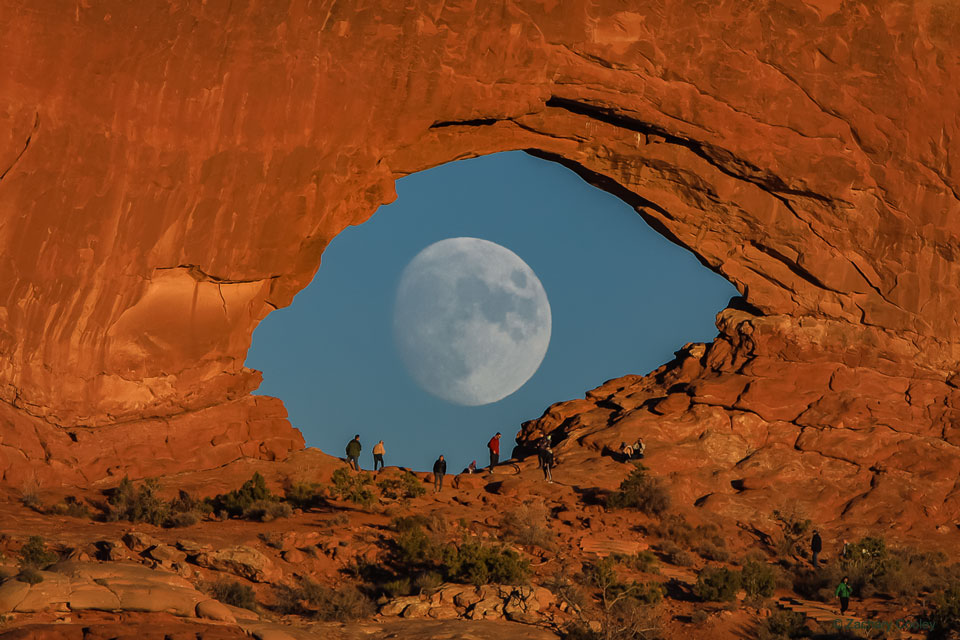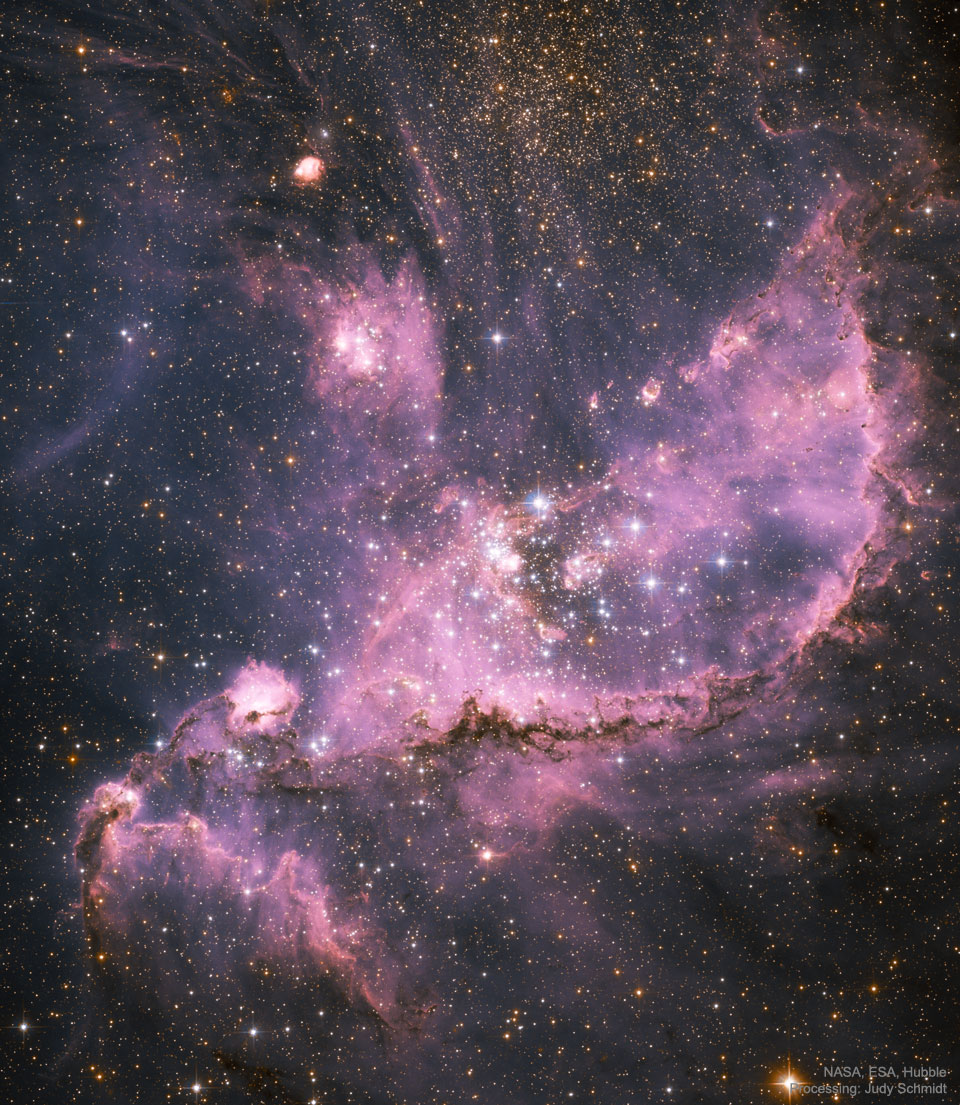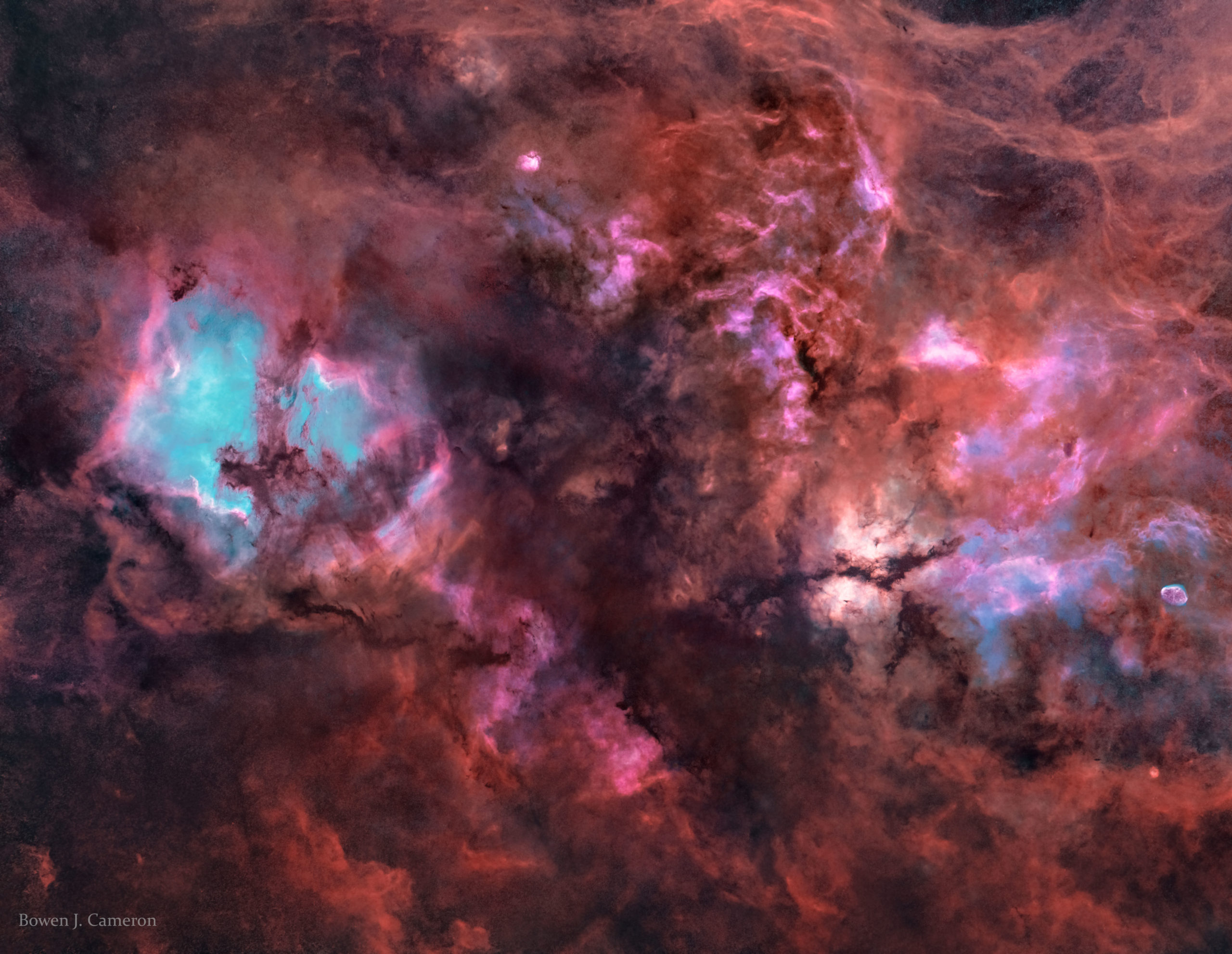Blog
The featured image of the Moon through a gap in a wall of rock may appear like a giant eye looking back at you. Although, in late October, it took only a single exposure to capture this visual double, it also took a lot of planning. The photographic goal was achieved by precise timing — needed for a nearly full moon to appear through the eye-shaped arch, by precise locating — needed for the angular sizeof the Moon to fit iconically inside the rock arch, and by good luck — needed for a clear sky and for the entire scheme to work. The seemingly coincidental juxtaposition was actually engineered with the help of three smartphone apps. The pictured sandstone arch, carved by erosion, is millions of years old and just one of thousands of natural rock arches that have been found in Arches National Park near Moab, Utah, USA. Contrastingly, the pictured Moon can be found up in the sky from just about anywhere on Earth, about half the time.

Tal Wilkenfeld (born 2 December 1986) is an Australian singer, songwriter, bassist and guitarist whose career began performing alongside artists including Jeff Beck, Prince, Eric Clapton, Herbie Hancock and Mick Jagger. In 2008, Wilkenfeld was voted “The Year’s Most Exciting New Player” by Bass Player magazine readers’ choice poll. In 2013, Wilkenfeld was awarded Bass Player Magazine’s “Young Gun Award” by Don Was, where she performed “Chelsea Hotel” by Leonard Cohen.
Wilkenfeld is a bandleader of her own eponymous bands in which she sings, plays bass and guitar. In her earlier work, she was backed by musicians such as Wayne Krantz and Vinnie Colaiuta. She opened for The Who on the North American part of The Who Hits 50! tour in 2016. In 2016, Wilkenfeld released a single entitled “Corner Painter” which features Blake Mills and Benmont Tench. Rolling Stone praised “Wilkenfeld is working on new music that sees her evolving from an instrumental prodigy into a formidable singer-songwriter” On 15 March 2019, Wilkenfeld released her vocal debut album Love Remains, which reached No. 1 on the Billboard Heatseeker charts on the first week of its release. Love Remains has been highly praised by the press and featured in Rolling Stone, Relix, Paste, Billboard and Forbes. Rolling Stone described Wilkenfeld’s vocal debut as “ten dense, riff-heavy tracks with brazen, introspective lyrics—prove her songwriting abilities.” Wilkenfeld has also been a guest on popular podcasts including Marc Maron and Bill Burr. Wilkenfeld was featured on the cover of Bass Player magazine’s March 2019 issue. On 22 July 2019, Wilkenfeld appeared on Jimmy Kimmel Live, performing “Killing Me” and “Corner Painter”.
https://www.youtube.com/watch?v=Kn2Yvjd5kqY
more...Ronald Mathews (December 2, 1935 in New York City – June 28, 2008 in Brooklyn) was an American jazz pianist who worked with Max Roach from 1963 to 1968 and Art Blakey‘s Jazz Messengers. He acted as lead in recording from 1963 and 1978–79. His most recent work was in 2008, as both a mentor and musician with Generations, a group of jazz musicians headed by veteran drummer Jimmy Cobb. He contributed two new compositions for the album that was released by San Francisco State University’s International Center for the Arts on September 15, 2008.
Critics have compared him to pianists Thelonious Monk, Bud Powell, and McCoy Tyner.
In his twenties, Mathews toured internationally and recorded with Roach, Freddie Hubbard and Roy Haynes. He was also a member of Art Blakey’s Jazz Messengers in the late 1950s through the 1960s. By thirty, he began teaching jazz piano and led workshops, clinics and master classes at Long Island University in New York City. Besides Dexter Gordon and Clark Terry, he toured and recorded on two Louis Hayes projects in the 70’s (i.e. the Louis Hayes-Woody Shaw Quintet and the Louis Hayes-Junior Cook Quintet).
more...Wynton Charles Kelly (December 2, 1931 – April 12, 1971) was an American jazz pianist and composer. He is known for his lively, blues-based playing and as one of the finest accompanists in jazz. He began playing professionally at the age of 12 and was pianist on a No. 1 R&B hit at the age of 16. His recording debut as a leader occurred three years later, around the time he started to become better known as an accompanist to singer Dinah Washington, and as a member of trumpeter Dizzy Gillespie‘s band. This progress was interrupted by two years in the United States Army, after which Kelly returned to Washington and Gillespie, and played with other leaders. Over the next few years, these included instrumentalists Cannonball Adderley, John Coltrane, Hank Mobley, Wes Montgomery, and Sonny Rollins, and vocalists Betty Carter, Billie Holiday, and Abbey Lincoln.
Kelly attracted the most attention as part of Miles Davis‘ band from 1959, including an appearance on the trumpeter’s Kind of Blue, often mentioned as the best-selling jazz album ever. After leaving Davis in 1963, Kelly played with his own trio, which recorded for several labels and toured the United States and internationally. His career did not develop much further, and he had difficulty finding enough work late in his career. Kelly, who was known to have epilepsy, died in a hotel room in Canada following a seizure, aged 39.
more...Charlie Ventura (born Charles Venturo; December 2, 1916 – January 17, 1992) was a tenor saxophonist and bandleader from Philadelphia, Pennsylvania.
During the 1940s, Ventura played saxophone for the bands of Gene Krupa and Teddy Powell. In 1945 he was named best tenor saxophonist by DownBeat magazine. He led a band which included Conte Candoli, Bennie Green, Boots Mussulli, Ed Shaughnessy, Jackie Cain, and Roy Kral.He led big bands in the 1940s and 1950s and formed the Big Four with Buddy Rich, Marty Napoleon, and Chubby Jackson. He was a sideman with Krupa through the 1960s, then worked in Las Vegas with comedian Jackie Gleason. In 1992 he died of lung cancer.
more...Found among the Small Magellanic Cloud’s (SMC’s) clusters and nebulas, NGC 346 is a star forming region about 200 light-years across, pictured here in the center of a Hubble Space Telescope image. A satellite galaxy of the Milky Way, the Small Magellanic Cloud (SMC) is a wonder of the southern sky, a mere 210,000 light-years distant in the constellation of the Toucan (Tucana). Exploring NGC 346, astronomers have identified a population of embryonic stars strung along the dark, intersecting dust lanes visible here on the right. Still collapsing within their natal clouds, the stellar infants’ light is reddened by the intervening dust. Toward the top of the frame is another star cluster with intrinsically older and redder stars. A small, irregular galaxy, the SMC itself represents a type of galaxy more common in the early Universe. These small galaxies, though, are thought to be building blocks for the larger galaxies present today.

John Francis Anthony “Jaco” Pastorius III (/ˈdʒɑːkoʊ pæˈstɔːriəs/; December 1, 1951 – September 21, 1987) was an American jazz bassist who was a member of Weather Report from 1976 to 1981. He worked with Pat Metheny and Joni Mitchell, and recorded albums as a solo artist and band leader. His bass playing employed funk, lyrical solos, bass chords, and innovative harmonics. As of 2017, he is the only electric bassist of seven bassists inducted into the DownBeat Jazz Hall of Fame, and has been lauded as one of the best electric bassists of all time.
Pastorius suffered from drug addiction and mental health problems throughout his professional life, and despite his widespread acclaim, over the latter part of his life he had problems holding down jobs due to his unreliability. In frequent financial trouble, he was often homeless throughout the mid 1980s. He died in 1987, as a result of injuries sustained in a fight outside of a South Florida music club.
After his death, his work continued to influence musicians. He was elected to the DownBeat Hall of Fame in 1988. He was the subject of the 2014 documentary film Jaco.
John Francis Pastorius was born December 1, 1951, in Norristown, Pennsylvania. He was the oldest of three boys born to Stephanie, his Finnishmother, and Jack Pastorius, a singer and jazz drummer who spent much of his time on the road. His family moved to Oakland Park near Fort Lauderdale when he was eight.
Pastorius’ nickname, “Jaco”, became adopted, and was partially influenced by his love for sports as well as the umpire Jocko Conlan. In 1974, he began spelling it “Jaco” after it was misspelled by his neighbor, pianist Alex Darqui. His brother called him “Mowgli” after the wild boy in The Jungle Book because he was energetic and spent much of his time shirtless on the beach, climbing trees, running through the woods, and swimming in the ocean. He attended St. Clement’s Catholic School in Wilton Manors and was an altar boy at St. Clement’s Church. His confirmation name was Anthony, thus expanding his name to John Francis Anthony Pastorius. He was intensely competitive and excelled at baseball, basketball, and football.
He played drums until he injured his wrist playing football when he was thirteen. The damage was severe enough to warrant corrective surgery and inhibited his ability to play the drums. By 1968–1969, at the age of 17, Pastorius had begun to appreciate jazz and had saved enough money to buy an upright bass. Its deep, mellow tone appealed to him, though it strained his finances. He had difficulty maintaining the instrument, which he attributed to the humidity in Florida. When he woke one day to find it had cracked, he traded it for a 1962 Fender Jazz Bass. In his teens he played bass guitar for Wayne Cochran and the C.C. Riders. In the early 1970s, Pastorius taught bass at the University of Miami, where he befriended jazz guitarist Pat Metheny, who was also on the faculty. With Paul Bley, Pastorius and Metheny recorded an album, later titled Jaco (Improvising Artists, 1974). Pastorius then played on Metheny’s debut album, Bright Size Life(ECM, 1976). He recorded his debut solo album, Jaco Pastorius (Epic, 1976) with Michael Brecker, Randy Brecker, Herbie Hancock, Hubert Laws, Pat Metheny, Sam & Dave, David Sanborn, and Wayne Shorter.
more...
Sander Lloyd Nelson (born December 1, 1938) is an American drummer. Nelson, one of the best-known rock drummers of the early 1960s, had several solo instrumental Top 40 hits and was a session drummer on many other well-known hits, and released over 30 albums. He lives in Boulder City, Nevada, and continues to experiment with music on keyboards and piano.
His first recording, with a band called the Renegades (Richard Podolor, Bruce Johnston, and Nick Venet), was “Geronimo”, written by Venet, produced by Kim Fowley, and released on the Original Sound Records label. Although it flopped on the national charts, it charted in some of the Mid West markets. The song, along with “Charge”, is part of the soundtrack of 1959 film Ghost of Dragstrip Hollow released by American International Pictures.
Nelson attended high school with Jan Berry, Dean Torrence (who became Jan and Dean), and Kim Fowley. After gaining respect as a session drummer, he played on such songs as “To Know Him Is To Love Him” (Phil Spector‘s Teddy Bears, 1958), “Alley-Oop” (The Hollywood Argyles, 1960), and “A Thousand Stars” (Kathy Young and the Innocents, 1960).
His instrumental recording “Teen Beat“, on Original Sound Records, rose to number 4 on the Billboard Hot 100 chart in 1959. It sold over one million copies, and was awarded a gold disc.Subsequently, he signed with the Imperial label, and pounded out two more Top 40 hits, “Let There Be Drums“, which went to number 7 on the Billboard Hot 100, and “Drums Are My Beat”. In December 1961, the British music magazine, NME, reported that “Let There Be Drums” had gone Top 10 in both the United Kingdom and United States. All three were instrumentals (a feat rarely repeated). Guitar playing on these hits was by co-writer Richard Podolor, later a songwriter and record producer.
https://www.youtube.com/watch?v=d4jmhXstTKI
more...Jimmy Lyons (December 1, 1931 – May 19, 1986) was an alto saxophone player. He is best known for his long tenure in the Cecil Taylor Unit. Lyons was the only constant member of the band from the mid-1960s until his death in 1986. Taylor never worked with another musician as frequently as he did with Lyons. Lyons’ playing, influenced by Charlie Parker, kept Taylor’s avant-garde music tethered to the jazz tradition.
Lyons was born in Jersey City, New Jersey and raised there until the age of 9, when his mother moved the family to Harlem and then the Bronx. He obtained his first saxophone in the mid-1940s and took lessons from Buster Bailey.
After high school, Lyons was drafted into the United States Army and spent 21 months on infantry duty in Korea. He then spent a year playing in army bands. Once discharged he attended New York University. By the end of the 1950s, Lyons was supporting his interest in music by working for the United States Postal Service.
In 1961, Lyons followed Archie Shepp into the saxophone role in the Cecil Taylor Unit. His post-Parker sound and strong melodic sense became a defining part of the sound of that group,from the 1962 Cafe Montmartre sessions onwards.
more...John Bunch (December 1, 1921 – March 30, 2010) was an American jazz pianist.
Born and raised in Tipton, Indiana, a small farming community, he studied piano with George Johnson, a well-known Hoosier jazz pianist. By the age of 14 he was already playing with adult bands in central Indiana.
During World War II he enlisted in the Air Corps and became a bombardier on a B17 Flying Fortress. He and his ten-man crew were transferred to combat duty in England, flying bombing missions over Germany. His plane was shot down 2 November 1944 and Bunch was taken prisoner. In prison camp he learned to arrange for big bands.
After the war, he applied for university training as a music major, but was refused because he couldn’t sight read classical music. He worked later in factories and insurance. In 1956 he moved to Los Angeles where he immediately was accepted by jazz musicians such as Georgie Auld and Jimmie Rowles, who later recommended him to Woody Herman. He settled in New York in 1958, where he joined Eddie Condon and Maynard Ferguson. He recorded with Ferguson and many smaller groups.
more...Ike Isaacs (December 1, 1919, Rangoon, Burma – January 11, 1996, Sydney, Australia) was a jazz guitarist from Rangoon, Burma, best known for his work with violinist Stéphane Grappelli.
Isaacs was self taught on guitar. He started playing professionally in college while pursuing a degree in chemistry. In 1946 he moved to England, where he became a member of the BBC Show Band. During the 1960s and ’70s, he was a member of the Hot Club of London, led by guitarist Diz Disley, which often collaborated with Stéphane Grappelli. He was a member of the band Velvet with Digby Fairweather, Len Skeat, and Denny Wright. In the 1980s, he moved to Australia and taught at the Sydney School of Guitar.
more...The sky is filled with faintly glowing gas, though it can take a sensitive camera and telescope to see it. For example, this twelve-degree-wide view of the northern part of the constellation Cygnus reveals a complex array of cosmic clouds of gas along the plane of our Milky Way galaxy. The featured mosaic of telescopic images was recorded through two filters: an H-alpha filter that transmits only visible red light fromglowing hydrogen atoms, and a blue filter that transmits primarily light emitted by the slight amount of energized oxygen. Therefore, in this 18-hour exposure image, blue areas are hotter than red. Further digital processinghas removed the myriad of point-like Milky Way stars from the scene. Recognizable bright nebulas include NGC 7000 (North America Nebula), and IC 5070 (Pelican Nebula) on the left with IC 1318 (Butterfly Nebula) and NGC 6888 (Crescent Nebula) on the right — but others can be found throughout the wide field.

More Posts
- The Cosmos with Trapezium Cluster
- Stanley Clarke Day
- Andrew Hill Day
- World Music with Nico Kasanda
- Daily Roots with Hortense Ellis
- The Cosmos with M24
- Gilberto Gil Day
- Julian Priester Day
- World Music with Paco De Lucia
- Daily Roots with Alton Ellis & the Heptones
- The Cosmos with Sharpless 2-106
- John Medeski Day
- David Honeyboy Edwards Day
- World Music with Odpoczno
- Daily Roots with Ras Tweed
- The Cosmos with M8
- Johnny “Big Moose” Walker Day
- Elmo Hope Day
- Shad Collins Day
- World Music with Eleftheria Arvanitaki